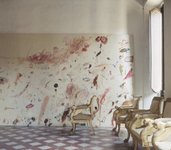Creativity
In many ways, I feel fortunate that we built Poolsuite, Vacation® and other projects before AI became as accessible as it is now. That time gave me a runway to hone the skill of being creative. But the other day, I found myself slipping into a terrible new habit, and turning to ChatGPT before I even gave my brain 30 seconds to... See more
PALM REPORT
So everything's... See more
“When there’s a deadline, there’s also a destination, a context, a reason for something…”—is attributed to Brian Eno. This idea appears in his public lectures and interviews, notably at the Red Bull Music Academy in 2013, where Eno discusses how deadlines transform creative experiments into finished work.
Tim Urban • How to Pick a Career
Contrast this with Henrik Karlsson on the importance of “context”. Somewhere in the spectrum? Or a different axis from creating vs. copying altogether?

Sari Azout • The End of Productivity
To and Fro
Most of the time when we feel stuck, it’s not because we don’t have ideas.
It’s because our ideas aren’t moving.
Today I looked up the word circulation, and one part of the definition grabbed me by the collar:
“Movement to and fro or around something.”
To and fro.
It feels like the rhythm of thinking itself.
Ideas come to you — in the shower,
... See moredegrees of freedom
